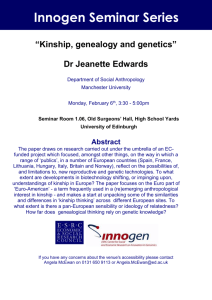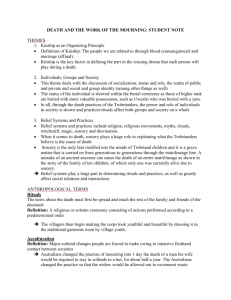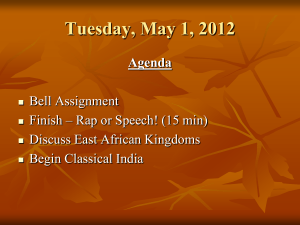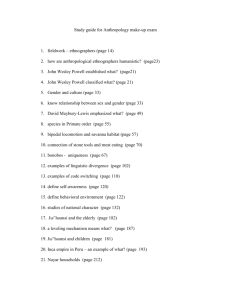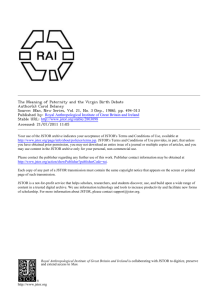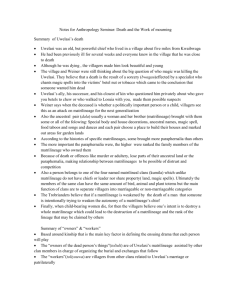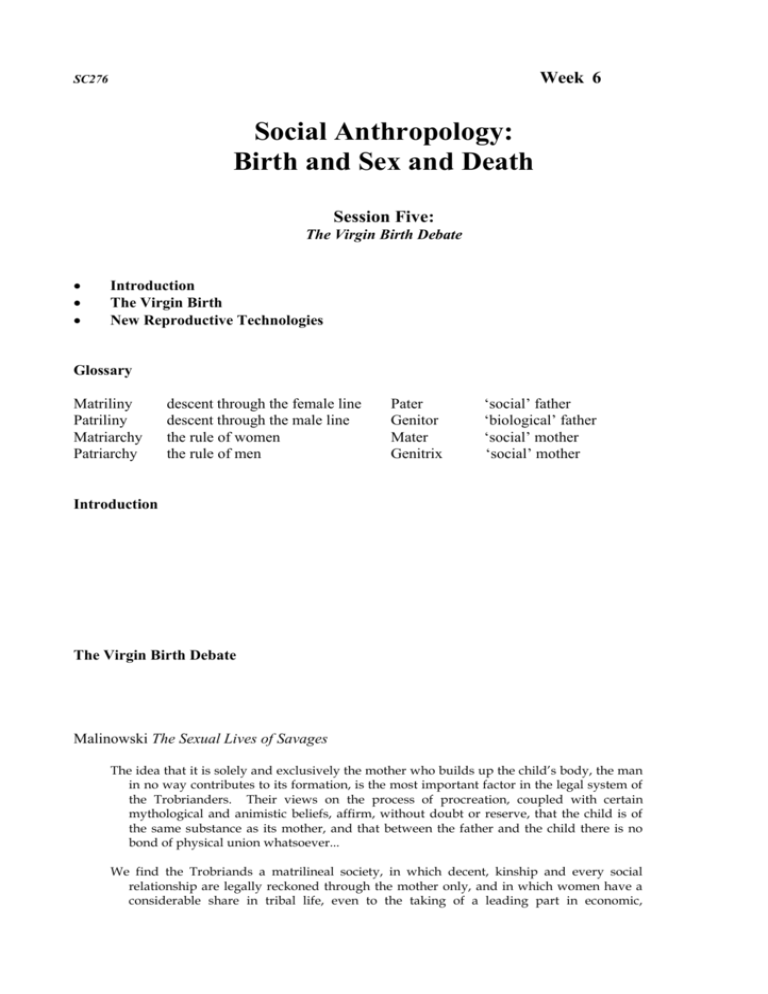
Week 6
SC276
Social Anthropology:
Birth and Sex and Death
Session Five:
The Virgin Birth Debate
Introduction
The Virgin Birth
New Reproductive Technologies
Glossary
Matriliny
Patriliny
Matriarchy
Patriarchy
descent through the female line
descent through the male line
the rule of women
the rule of men
Pater
Genitor
Mater
Genitrix
‘social’ father
‘biological’ father
‘social’ mother
‘social’ mother
Introduction
The Virgin Birth Debate
Malinowski The Sexual Lives of Savages
The idea that it is solely and exclusively the mother who builds up the child’s body, the man
in no way contributes to its formation, is the most important factor in the legal system of
the Trobrianders. Their views on the process of procreation, coupled with certain
mythological and animistic beliefs, affirm, without doubt or reserve, that the child is of
the same substance as its mother, and that between the father and the child there is no
bond of physical union whatsoever...
We find the Trobriands a matrilineal society, in which decent, kinship and every social
relationship are legally reckoned through the mother only, and in which women have a
considerable share in tribal life, even to the taking of a leading part in economic,
ceremonial, and magical activities -- a fact which very deeply influences all the customs of
erotic life as well as the institution of marriage
1.
What is Malinowski implying is the link between ignorance of paternal contribution to
conception and the culture and social structure of the Trobrianders?
2.
How do the Trobrianders differ from the Basques studied by Ott or Aristotle’s ideas on
conception? In particular, what are the social aspects which are relevant to understandings of
conception?
.
2
Read:
The correlation of the mystical with the physiological aspects in pregnancy belief – or
the origin of the child in Tuma (spirit world) and its journey to the Trobriands with the
subsequent processes in the maternal body, the welling up of the blood from the
abdomen to the head and down again from the head to the womb – provides a coordinated and self-contained…theory for the origin of human life. It also gives a good
theoretical foundation for matriliny; for the whole process of introducing new life into a
community lies between the spirit world and the female organism. There is no room for
any sort of physical paternity’ (Sexual Life of Savages 1939: 153).
‘We must realise that the cardinal dogma of the God the Father and God the Son and
the filial love of man to his Maker would completely miss fire in a matrilineal society,
where the relation between the father and the son is decreed by tribal law to be that of
two strangers, where all personal unity between them is denied and where all family
obligations are associated with the mother-line…The whole concept of Christian
morality...is strongly associated with the institution of a patrilineal and patriarchal
family, with the father as progenitor and master of the household. We cannot then
wonder that Paternity must be among the principal truths to be inculcated by the
proselytising Christians.’ The Sexual Lives of Savages (1929:159)
1. Why was paternity so important for the Christian missionaries?
2. How is the whole concept of Christian morality associated with the institution of a patrilineal
and patriarchal family?
3. Why is it important for the missionaries for the father to be seen as the progenitor (as opposed to
one of two progenitors)?
Consider the procreation beliefs of the Trobrianders, Vezo and Basques
In what ways are their beliefs scientific?
In what ways are their beliefs irrational?
How do you know how conception occurs?
How obvious is it that you need a man and a woman to have sex in order for the woman to
conceive?
3
New Reproductive Technologies
Now biological parenthood does not replicate with exactness the old
concept of natural kinship…There is a new ambiguity about what should
count as natural. The ‘natural’ father was once the progenitor of child
born out of wedlock; the ‘natural’ mother was once the progenitor of a
child relinquished for adoption. Ideally, the social parent combined both
biological and legal credentials, although it was not ordinarily necessary
to mark the parent this way…Assisted reproduction creates biological
parents as a separate category. By the same process, the social parent
becomes marked as potentially deficient in biological credentials.’
Strathern 1992 Reproducing the Future: Essays in Anthropology,
Kinship and New reproductive Technologies.
Consider contemporary western procreation beliefs.
How are babies made? What is the essential process for creating human life?
How are children related to their parents?
What are natural parents and what are non-natural parents?
Are fathers and mothers different in ways they relate to their children, in substance or in
their social relationships?
How are physical relationships implicated in social relationships? That is, what difference
does it make if your father is not your ‘real’ father? What does this sentence mean,
anyway?
Is ‘natural’ kinship about shared substance or sharing something else?
If natural kinship is about shared substance what is that substance?
4

